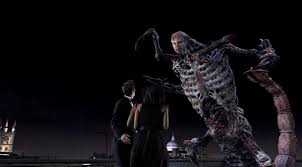
In London, an elderly professor named Richard Lazarus (Mark Gatiss) announces on TV that he has a device that will change what it means to be human. Intrigued, the Doctor (David Tennant) joins Martha Jones (Freema Agyeman) at the launch party at Lazarus Industries, where her sister Trish (Gugu Mbatha-Raw) works. Lazarus steps inside a capsule and emerges a younger man. Analyzing his DNA, the Doctor and Martha discover that Lazarus has rejuvenated his genes with sound waves, but his DNA keeps changing.
Lazarus returns to his office with his partner Lady Thaw (Thelma Barlow). She wants to use the machine too, so they can be young together, but he says no. She threatens to have the powerful Mister Saxon cut off their funding. Lazarus transforms into a monster and kills her. The Doctor and Martha discover her body and believe Lazarus has drained her life energy to keep his DNA stable.
Lazarus attacks the Doctor and Martha as a giant skeletal scorpion-like creature, and they hide in his machine. The Doctor believes that an evolutionary throwback locked in Lazarus’ dormant genes was unlocked by the rejuvenating process. Lazarus tries to destroy them by activating the machine, but the Doctor sets the capsule to reflect energy, not focus it, and Lazarus is blasted away.
His body is taken in an ambulance. Martha’s mother Francine (Adjoah Andoh) has been told by Harold Saxon that the Doctor is dangerous. The Doctor hears the ambulance crash and finds the drivers drained of life. The Doctor, Martha, and Trish chase Lazarus to the Southwark Cathedral, where Lazarus sought sanctuary during the Blitz as a child. Martha and Trish lure Lazarus to the top of the bell tower and the Doctor prepares the pipe organ to blast its maximum volume. The vibrations interfere with Lazarus’ DNA and he falls to his death. The Doctor invites Martha to be a companion and they leave in the TARDIS.
Writer Stephen Greenhorn was told to write something like a Marvel Comic—a mad scientist, an experiment gone wrong, and an outrageous supervillain. The story was not only influenced by Doctor Octopus and the Green Goblin, but by The Fly, Doctor Jekyll and Mister Hyde, and as usual, The Quatermass Experiment. The creature Lazarus devolved into was inspired by the original centipede- and scorpion-like creatures that first emerged from the sea 470 million years ago. The prosthetics worn by Mark Gatiss as an old man was based on a head-cast of Vincent Price. Mark Gatiss was a writer for the BBC and one of only five people who both wrote and acted for Doctor Who.
Martha says the Doctor in a dinner jacket looks Bond-like and he is flattered. He turns the organ up to 11 in a reference to the movie Spinal Tap, and he fixes the capsule by reversing the polarity—an in-joke reference to Jon Pertwee, the Third Doctor, who was always pulling that trick. Lazarus is, of course, named after the man in the Gospel According to John who was brought back to life by Jesus. Both the Doctor and Lazarus refer to poet T. S. Eliot, particularly the Love Song of J. Alfred Prufrock, as in “I am Lazarus come back from the dead.” And I would add, “I should have been a pair of ragged claws, scuttling across the floors of silent seas.”
